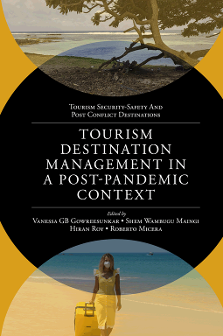
Index
Tourism Destination Management in a Post-Pandemic Context
ISBN: 978-1-80071-512-7, eISBN: 978-1-80071-511-0
Publication date: 11 June 2021
Citation
(2021), "Index", Gowreesunkar, V.G., Maingi, S.W., Roy, H. and Micera, R. (Ed.) Tourism Destination Management in a Post-Pandemic Context (Tourism Security-Safety and Post Conflict Destinations), Emerald Publishing Limited, Leeds, pp. 335-343. https://doi.org/10.1108/978-1-80071-511-020211026
Publisher
:Emerald Publishing Limited
Copyright © 2021 Emerald Publishing Limited
INDEX
- Prelims
- Introduction: Destination Management Solutions Post Pandemic: A Need of the Hour!
- Part 1 Destination Management Post Pandemic
- Chapter 1 The Recovery Tactics of the Tourism Industry Amid COVID-19 Pandemic Conditions in the Baltic States
- Chapter 2 Destination Management Solution Post COVID-19: Best Practice from Bali – A World Cultural Tourism Destination
- Chapter 3 Heritage Tourism and COVID-19: Turning the Crisis into Opportunity within the Egyptian Context
- Chapter 4 COVID-19 Pandemic and the Accommodation Sector in Sardinia, Italy: Impacts and Response Actions
- Part 2 Disaster Management Post Pandemic
- Chapter 5 Tourism Disaster Preparedness Post-COVID-19 Pandemic: The Example of Argentina
- Chapter 6 Tourist Safety and Security Post COVID-19: Global Perspectives
- Chapter 7 Uganda Tourism Sector COVID-19 Response, Recovery and Sustainability Strategies: Lessons from Previous Virus Disease Outbreaks
- Chapter 8 Tourism Resilience in the Context of Tourism Destination Management in Post-COVID-19 Bangladesh
- Part 3 Local Communities and Destination Recovery Post Pandemic
- Chapter 9 Exploring Impacts of a Health Crisis on Emotional Solidarity and Support for Tourism: Case of Mauritius
- Chapter 10 Residents as Destination Influencers during COVID-19
- Chapter 11 Contributions and Challenges of Civil Society Organizations in Tourism in Kenya
- Chapter 12 Gender Disparities in Employability in the Tourism Sector Post-COVID-19 Pandemic: Case of South Africa
- Part 4 Marketing and Promotion of Destinations Post Pandemic
- Chapter 13 Effect of Perceived Risk on Tourists’ Behavioural Intentions Post COVID-19 in Turkey
- Chapter 14 Enhancing Cultural Heritage at the Time of the COVID-19 Outbreak: An Overview of the ICT Strategies Adopted by Museums in the Campania Region of Italy
- Chapter 15 Sport Events and Tourism for the Sustainable Local Development Post COVID
- Part 5 Sustaining Tourism Post Pandemic
- Chapter 16 Challenges in Developing Sustainable Tourism Post COVID-19 Pandemic
- Chapter 17 Impact of COVID-19 Pandemic on Social Sustainability in Tourism: A Study of Uttarakhand State of India
- Chapter 18 Redefining Sustainability in the Conservation and Promotion of the Cultural Heritage Tourism Product in Kenya
- Chapter 19 Does Your Post-COVID-19 Travel Dream Talk about Sustainability? Insights from Potential Tourists in India
- Part 6 Tourism Education Post Pandemic
- Chapter 20 Resilience Adaptations in Tourism Education for the Post-COVID-19 Era – A Study of India
- Chapter 21 Reviving Tourism in India Post COVID-19 Pandemic: Role of Tourism Education and Training
- Chapter 22 Adopt, Adapt or Perish: Re-building Support Systems for Travel and Tourism Education in COVID-19 Educational Crisis
- Conclusion: Rebuilding Tourism Post Pandemic: Some Reflections on Destination Management Solutions!
- Index